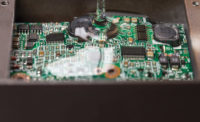Plasma Treatment Boosts Adhesion

You may already know something about the benefits of plasma treatment, such as higher treatment (dyne) levels, extended life of treatment over time, the lack of surface morphology degradation, and the elimination of pinholing and backside treatment.
Until recently, low-pressure vacuum plasmas have been used to treat two- and three-dimensional plastic objects and polymer films. The recent introduction of high-density atmospheric plasma for film, foil, paper, foam, nonwoven and woven substrate applications has had a significant impact on the surfaces of these materials at considerably lower capitalization costs.
High-density atmospheric plasma represents a new generation of surface-treatment technology. It allows plasmas to be sustained at atmospheric pressure in a way that permits the surface treatment of polymers and other substrates. It can be configured to work with a variety of feeding systems, including continuous web.

How does Plasma Compare to Corona?
Corona treatment is an electrical process that uses ionized air to increase the surface tension of non-porous substrates. Normally, corona-treating systems operate at an electrical voltage of approximately 10 kV.Like corona, plasma is the electrical ionization of a gas. The plasma (glow) discharge creates a smooth, undifferentiated cloud of ionized gas with no visible electrical filaments. However, unlike corona, plasma is created at much lower voltage levels and temperatures.

Plasma Effects on Substrate Surfaces
Corona converts the substrate surface from a non-polar state to a polar state. Oxygen molecules from the corona discharge area are then free to bond to the ends of the molecules in the substrate being treated, resulting in an increase in surface tension.The same description holds true for atmospheric plasma, with a few exceptions. The rate at which electron bombardment occurs within a high-density atmospheric plasma is up to 100 times greater. This increased electron activity forces greater ion bombardment to the substrate surface. This results in increased etching, chain scission and crosslinking on the substrate's surface, which influences stronger bonding attributes across the surface of the web. Specifically, mechanical interlocking is enhanced, bonding materials together by allowing the adhesive or sealant to take advantage of the microscopic roughness etched to the surface by atmospheric plasma, locking them together. In addition, covalent chemical bonding is promoted, using mutually reactive chemical groups newly resident at the substrate surface (delivered by atmospheric plasma treatment) and the adhesive to form the strongest, most durable bond.
Summarizing the treatment process, high-density atmospheric plasma employs chemical gases that produce controlled chemical reactions on the surface. Chemistry molecules that are introduced are propelled to the material surface. Low-molecular-weight material is cleaned from the surface and specific gas molecules covalently bond to the surface. This is how adhesion can be boosted between the adhesive and the material surface.
Atmospheric plasma technology also eliminates the possibility of backside treatment. The high-speed photos capture the optical differences between corona and atmospheric plasma treatment. The corona image shows the expected "filaments," while the plasma treatment generates a smooth treat pattern.

Benefits of Atmospheric Plasma for Adhesive Adhesion
Plasma treatment offers three key benefits that adhesive manufacturers can use to their advantage.1. Longer life treatments. Substrates that have been atmospheric plasma-treated hold their treatment levels longer than corona-treated surfaces. Longer treatment life allows product converters to take advantage of economies of scale during production, increase inventory life and provide enhanced manufacturing flexibility.
2. Higher treat levels allow for treatment of difficult-to-treat surfaces. Atmospheric plasma treatment is a viable alternative for substrates for which corona treating is ineffective. For example, difficult-to-treat fluoropolymer-based materials like Teflon® do not respond to the corona process but do respond to atmospheric plasma treatment.
3. Treatment of thicker substrates. While substrates that are thicker than 0.125" usually do not respond well to the corona process, they can be treated by atmospheric plasma. Films, metallized films, foils, foams, wovens and nonwovens are all candidates for atmospheric plasma surface treatment.
An atmospheric plasma treatment system called Plasma3™ that can operate at low temperature to provide the advantages plasma technology has over existing surface-treatment technologies has been developed by Enercon Industries. The surface energies of materials treated by this system have been shown to increase substantially, thereby significantly enhancing the wettability, printability and adhesive/ink/coating adhesion properties of these materials.
Web-Based Atmospheric Plasma Market Applications
Water- and solventborne, alcohol-based, and cold-seal adhesives are used for a variety of laminating applications. They are used by contract laminators and consumer products companies to bond multiple combinations of film, fiberglass, foam, fabric, paper, nonwovens, and rubber. The laminates are used to produce a range of products, including the following.- Packaging applications - sealing tapes, weather-strip, labels
- Automotive applications - seals, gaskets, headliners, trim
- Textile applications - protective apparel, outerwear
- Medical applications - medical drapes and garments, bandages, electrodes, labeling, lidding, covers
- Electronic applications
- Bonding/assembly and thermal management tapes
The system also has the flexibility to be operated with variable chemistries and without the generation of ozone, pin-holing, and backside treatment.
For more information, contact Rory Wolf at rwolf@enerconmail.com .
Looking for a reprint of this article?
From high-res PDFs to custom plaques, order your copy today!



